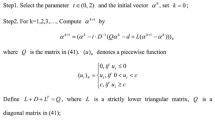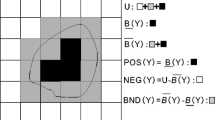Abstract
It is necessary to use interval data to define terms or describe extreme behaviors because of the existence of uncertainty in many real-world problems. In this paper, a novel efficient interval twin support vector regression (ITSVR) is proposed to handle such interval data. This ITSVR employs two nonparallel functions to identify the upper and lower sides of the interval output data, respectively, in which the Hausdorff distance is incorporated into the Gaussian kernel as the interval kernel for interval input data. Compared with other support vector regression (SVR)-based interval regression methods, such as the interval support vector interval regression networks (ISVIRN), this ITSVR algorithm is more efficient since only two smaller-sized QPPs are solved, respectively. The experimental results on several artificial datasets and three stock index datasets show the validity of ITSVR.







Similar content being viewed by others
References
Zadeh LA (1965) Fuzzy sets. Inf Control 8(3):338–353
Pawlak Z (1992) Rough sets: theoretical aspects of reasoning about data. Kluwer, Dordrecht
Ishibuchi H, Tanaka H (1990) Several formulations of interval regression analysis. In: Proc. sino-Japan joint meeting on fuzzy sets and systems, Beijing, China, pp B2–2
Ishibuchi H, Tanaka H (1992) Fuzzy regressiion analysis using neural networks. Fuzzy Sets Syst 50:57–65
Hashiyama T, Furuhash T, Uchikawa Y (1992) An interval fuzzy model using a fuzzy neural network. In: IEEE international conference neural networks. Baltimore, MD, USA, pp 745–750
Ishibuchi H, Tanaka H, Okada H (1993) An architecture of neural networks with interval weights and its application to fuzzy regression analysis. Fuzzy Sets Syst 57:27–39
Ishibuchi H, Nii M (2001) Fuzzy regression using asymmetric fuzzy coefficients and fuzzified neural networks. Fuzzy Sets Syst 119:273–290
Cheng C, Lee E (2001) Fuzzy regression with radial basis function network. Fuzzy Sets Syst 119:291–301
Vapnik VN (1998) Statistical learning theory. Wiley, New York
Jeng J-T, Chuang C-C, Su S-F (2003) Support vector interval regression networks for interval regression analysis. Fuzzy Sets Syst 138:283–300
Hong DH, Hwang C (2005) Interval regression analysis using quadratic loss support vector machine. IEEE Trans Fuzzy Syst 13:229–237
Hwang C, Hong DH, Seok KH (2006) Support vector interval regression machine for crisp input and output data. Fuzzy Sets Syst 157:1114–1125
Lingras P, Butz CJ (2010) Rough support vector regression. Eur J Oper Res 206(2):445–455
Hao P-Y (2009) Interval regression analysis using support vector networks. Fuzzy Sets Syst 160:2466–2485
Schölkopf B, Smola A, Williamson R et al. (2000) New support vector algorithms. Neural Comput 12(5):1207–1245
Chuang C-C (2008) Extended support vector interval regression networks for interval input-output data. Inf Sci 178:871–891
Do TN, Poulet F (2005) Kernel methods and visualization for interval data mining. In: Internaional symposium on applied stochastic models and data analysis, ASMDA’05, France, pp 345–355
Peng X (2010) TSVR: an efficient twin support vector machine for regression. Neural Netw 23:365–372
Peng X (2010) Primal twin support vector regression and its sparse approximation. Neurocomputing 73(16–18):2846–2858
Fung G, Mangasarian OL (2001) Proximal support vector machines. In: Proceedings of KDD-2001, San Francisco, pp 77–86
Platt J (1999) Fast training of support vector machines using sequential minimal optimization. In: Schölkopf B, Burges CJC, Smola AJ (eds) Advances in kernel methods-support vector learning. MIT Press, Cambridge, pp 185–208
Joachims T (1999) Making large-scale SVM learning practical. In: Schölkopf B, Burges C, Smola A (eds) Advances in kernel methods-support vector learning. MIT Press, Cambridge
Mangasarian OL, Musicant DR (1999) Successive overrelaxation for support vector machines. IEEE Trans Neural Netw 10(5):1032–1037
Allen DM (1974) The relationship between variable selection and prediction. Technometrics 16:125–127
Weisberg S (1985) Applied linear regression, 2nd edn. Wiley, New York
D’Urso P, Gastaldi T (2002) An “orderwise” polynomial regression procedure for fuzzy data. Fuzzy Sets Syst 130:1–19
Peng X (2012) Efficient twin parametric insensitive support vector regression model. Neurocomputing 79:26–38
Singh M, Chadha J, Ahuja P, Jayadeva Chandra S (2011) Reduced twin support vector regression. Neurocomputing 74(9):1474–1477
Zhao Y, Zhao J, Zhao M (2013) Twin least squares support vector regression. Neurocomputing 118:225–36
Tomar D, Agarwal S (2015) Twin support vector machine: a review from 2007 to 2014. Egypt Inform J 16(1):55–69
Acknowledgments
The authors thank the anonymous reviewers for their constructive comments and suggestions. This work is supported by the program of Shanghai Normal University (DZL121), the National Natural Science Foundation of Shanghai (12ZR1447100), the Natural Science Foundation of China (61202156), and the Natural Science Foundation of Zhejiang Province of China (Y6100588).
Author information
Authors and Affiliations
Corresponding author
Rights and permissions
About this article
Cite this article
Peng, X., Chen, D., Kong, L. et al. Interval twin support vector regression algorithm for interval input-output data. Int. J. Mach. Learn. & Cyber. 6, 719–732 (2015). https://doi.org/10.1007/s13042-015-0395-9
Received:
Accepted:
Published:
Issue Date:
DOI: https://doi.org/10.1007/s13042-015-0395-9




